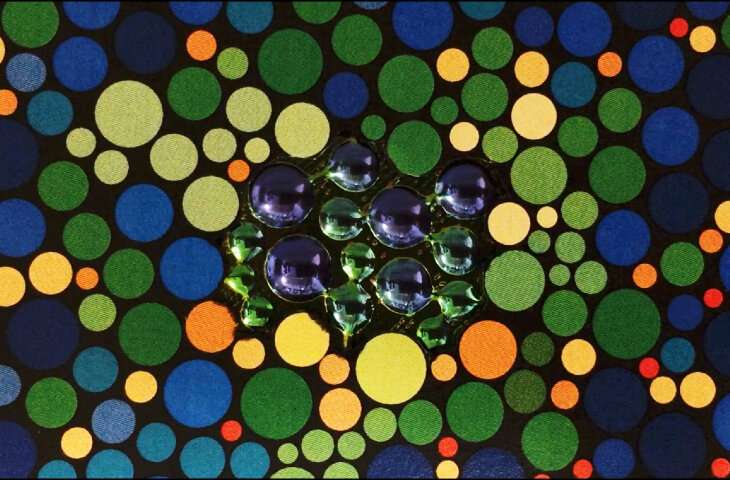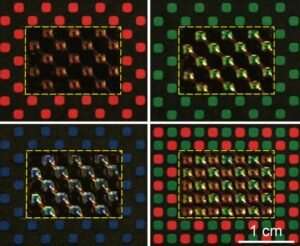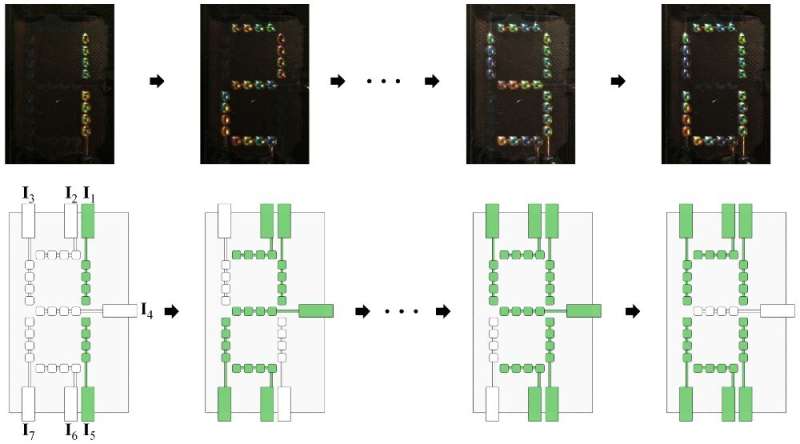Engineering a polymer network to act as active camouflage on demand

The animal kingdom is full of creatures with active camouflage. What looks like a drab pile of sand and rocks might actually be a brightly colored squid, expanding and contracting structures within their skin to reveal shades of brown and gray instead of vibrant blue and yellow. Known as chromatophores, these cells can expand and retract internal reflective plates in response to external stimuli, allowing the animal to match the colors and patterns of their surroundings, and disappear in an instant.
Now, researchers at the University of Pennsylvania's School of Engineering and Applied Science are taking inspiration from this kind of active camouflage. Using thin, flexible membranes made from a polymer network of liquid crystals that are arranged in helical shapes, these researchers have developed a kind of artificial chromatophore that can change colors instantly—from near-infrared to visible to ultraviolet—on command.
These membranes are situated over tiny cavities arranged in a grid, each of which can be pneumatically inflated to a precise pressure. As a cavity inflates, the membrane is stretched, shrinking its thickness and shifting its apparent color.
Critically, these membranes do not need to be stretched much to achieve this effect. Using an amount of pressure equivalent to a gentle touch, their color can be changed to anything within the visible spectrum. Color-changing materials that use similar mechanisms have historically needed to be deformed by 75 percent to shift from red to blue, making them impossible to use in settings with fixed dimensions, such as displays or windows.
Because the researchers' artificial chromatophores need less than 20 percent deformation to achieve the same effect, they can be arranged like pixels in an LCD monitor. And because the layered liquid crystals in the researchers' system have their own reflective color, they do not need to be backlit and thus don't need a constant source of power to maintain their intrinsically vibrant appearance.

While the researchers' prototype displays only have a few dozen pixels each, a study demonstrating the principle behind their color-changing ability outlines their potential in a variety of camouflage techniques, as well as applications in architecture, robotics, sensors and other fields.
The study, published in the journal Nature Materials, was led by Shu Yang, Joseph Bordogna Professor and Chair of the Department of Materials Science and Engineering, and Se-Um Kim, then a postdoctoral researcher in her lab. Fellow Yang lab members Young-Joo Lee, Jiaqi Liu, Dae Seok Kim and Haihuan Wang also contributed to the research.
"Our lab has always been interested in structural color, including how to change it by using mechanical forces," says Yang. "For example, we previously demonstrated that a color-changing polymer may signal traumatic brain injuries in soldiers and athletes. In looking at how some animals have evolved structural color, we realized they had stretchy cells that worked like pixels in a display and that we could potentially take a similar approach."
Structural color, the phenomenon that gives butterfly wings and peacock feathers iridescence that is often brighter than pigment or dye-based colors, is produced when light interacts with microscopic features of a surface. In the case of the researchers' displays, those features are found in a class of materials known as "main-chain chiral nematic liquid crystalline elastomers" or MCLCEs. Liquid crystals are intrinsically anisotropic materials, meaning their properties vary based on their directional orientation. The helical shape of MCLCEs allows for large and elastic anisotropy, since the pitch of the helix can be easily altered.
As a cavity in the display is inflated, its MCLCE membrane is stretched. Much like compressing a spring, this reduces the pitch of the liquid crystal helix within the membrane, changing the wavelength of light that is reflected at the viewer.

By plotting out the exact pressure required to get each artificial chromatophore to a desired color, the researchers were able to program them like the pixels in a display. This level of control is possible even without separate pneumatic pumps for each pixel.
"I wanted to generate red, green and blue color simultaneously in a simple operation," Kim says, "so I connected cavities of different width to the same air channel. This means that, despite experiencing the same pressure, the degree of deformation and the color varies from pixel to pixel, reducing the complexity of the overall device."
Using only two air channels, the researchers' prototype can produce 7-by-5 checkerboard patterns that match the shading and texture of a surrounding surface. With seven channels, they can render digits in the style of the seven-segment color displays found in LCD clocks
The researchers believe that the unique mechanochromic performance of MCLCEs will inspire the creation of new biomimetic photonic devices and sensors that are highly sensitive and complex despite the material's relatively simple mechanism. They also plan to further demonstrate 3D displays, as well as "smart" windows that respond to ambient temperatures by changing color.
More information: Se-Um Kim et al, Broadband and pixelated camouflage in inflating chiral nematic liquid crystalline elastomers, Nature Materials (2021). DOI: 10.1038/s41563-021-01075-3
Journal information: Nature Materials
Provided by University of Pennsylvania





















